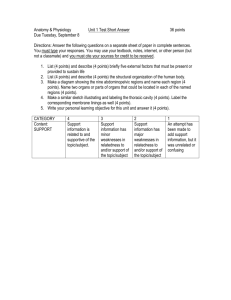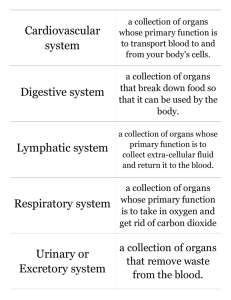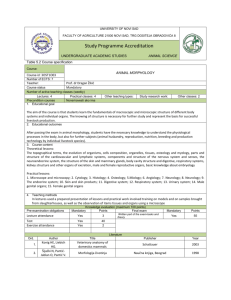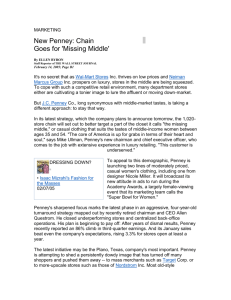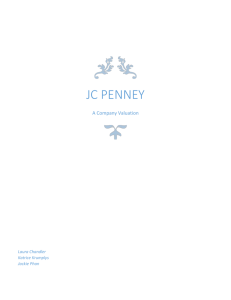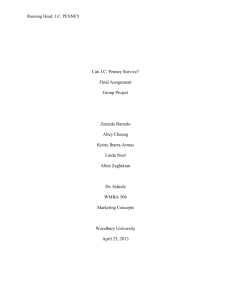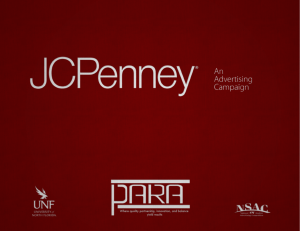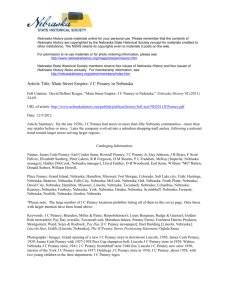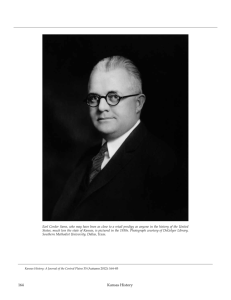7. Pig Dissection II
advertisement
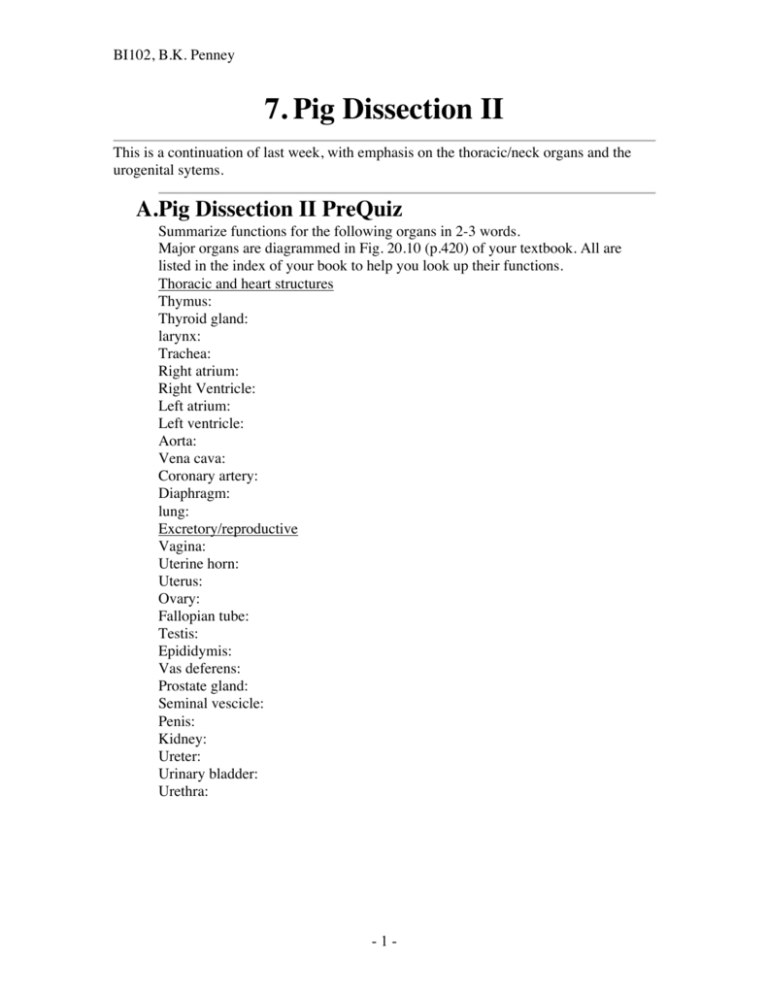
BI102, B.K. Penney 7. Pig Dissection II This is a continuation of last week, with emphasis on the thoracic/neck organs and the urogenital sytems. A.Pig Dissection II PreQuiz Summarize functions for the following organs in 2-3 words. Major organs are diagrammed in Fig. 20.10 (p.420) of your textbook. All are listed in the index of your book to help you look up their functions. Thoracic and heart structures Thymus: Thyroid gland: larynx: Trachea: Right atrium: Right Ventricle: Left atrium: Left ventricle: Aorta: Vena cava: Coronary artery: Diaphragm: lung: Excretory/reproductive Vagina: Uterine horn: Uterus: Ovary: Fallopian tube: Testis: Epididymis: Vas deferens: Prostate gland: Seminal vescicle: Penis: Kidney: Ureter: Urinary bladder: Urethra: -1- BI102, B.K. Penney -2- BI102, B.K. Penney 7. Pig Dissection II B. Thoracic organs and neck GOALS: o To examine the organs of the thoracic cavity, including the heart and lungs o Some of these organs extend into or are connected to important parts in the neck 3. Neck and thorax procedure 1. Open the thoracic cavity by inserting the scissors between the diaphragm and rib cage, just one side of center of the rib cage. Don't try to go straight up the center or you will be trying to cut the sternum, the breastbone. 2. Use the scissors to cut just one side of the sternum all the way to the top of the rib cage. Continue cutting through the skin all the way to the lower jaw. 3. Cute the diaphragm from the rib cage down the sides of the body. 4. You likely won't have cut deeply enough to see all of the neck organs. Feel with your finger until you can find the larynx (voicebox/Adam's apple). Gently cut deeper, about a millimeter at a time, until you can see the thyroid gland, which regulates development and metabolism. It looks like a tan bean and sits on top of the larynx. 5. You will need to make the cut slightly deeper both anterior and posterior to the thyroid gland, and then pull the skin away from the trachea, in order to see the thymus glands, which stimulates T cell development. 6. Open the rib cage by shaving the muscle layer away on either side. The forelimbs should now lay flat and you should be able to open the rib cage easily. 7. The heart and each lung should each be in a separate sac, but these may tear when you open the rib cage. The diaphragm– the muscle that expands the lungs– will form the bottom of this cavity. 8. Identify the structures labeled on the thorax and heart diagrams. -3- BI102, B.K. Penney 4. Neck and thorax diagram -4- BI102, B.K. Penney 5. Heart diagram 6. Trace the path of blood circulation through the heart and major arteries and veins in the thoracic view C.Excretory system GOALS: To see and understand the kindey and associated organs that filter nitrogenous wastes from the blood. 1. Excretory system exposure procedure 1. Note that you do NOT have to cut anything else for this portion! -5- BI102, B.K. Penney 2. Use your blunt probe to move the intestines to one side. One the back wall of the abdominal cavity you will see a large, firm, beanshaped organ that is buried under the back wall of the peritoneum. This is one kidney, which functions in osmoregulation and excretion of waste. For both of these functions, it produces urine. There is a matching kidney on the other side. 3. Toward the posterior side of the kidney, you should see the ureter, a long tube which carries urine to the urinary bladder. 4. The urinary bladder is the large, bag-like structure on the inside of the flap with the umbilical cord. It stores urine until it is expelled from the body. 5. At this point, do not try to expose the entire ureter to see its connection to the urinary bladder. You may destroy structures of the reproductive tract! 2. Diagram of the excretory organs of the fetal pig, female and male -6- BI102, B.K. Penney 3. D.Reproductive system GOALS: To see and understand the organs associated with production and transport of gametes, mating and gestation in both sexes. 1. Female reproductive system procedure 1. Locate the ovaries dorsal in the abdominal cavity. They will be attached to the abdominal wall via ligaments. 2. The tubes leading from each ovary towards the center are uterine horns. If you look closely, there are coiled uterine tubes (Fallopian tubes) leading from the uterine horns to the ovary. (One major difference is that fallopian tubes can not effectively handle the implantation of a placenta, while uterine horns can). 3. The central muscular area to which the uterine tubes lead is the uterus. -7- BI102, B.K. Penney 4. The uterus leads to a muscular vagina, which leads to the outside of the animal. Most of the vagina is buried in the musculature behind the pelvic girdle, so you will have to cut through the pelvic cartilage and lay the legs out flat, and then do exploratory cuts through the remaining tissue to find it. 2. Male reproductive system procedure 1. Use your scalpel to expose the penis, located immediately posterior to the umbilical cord via a hole called the preputial orifice. To avoid cutting through it, feel for it through the skin and make exploratory cuts downward until you reach it. 2. Expose the structures inside the scrotum on one side. Using your scalpel, make exploratory cuts through the outside of the scrotum until you have cut all the way through the skin but no further. lengthen this cut to the general body wall. 3. Find the testis and epididymis on the diagram, clearing more tissue with your probe if needed. The testes make sperm, which are matured in the epididymis. 4. Cut through the pelvic cartilage and lay the legs out flat, 5. Extend the cut past the pelvic girdle, using exploratory cuts to follow the tubes coming from the epididymis. The thin round tube is the vas deferens, which carries sperm from the testes to the penis. The flat, tough strap is a ligament to support the testis. 6. Cut through the pelvic girdle all the way to the inguinal canal, where the testis descends from the abdominal cavity during development. 7. By extending the cuts following the vas deferens and that exposing the base of the penis, you should be able to find where the two vas deferens meet at the base of the urinary bladder. Near the base of the penis, you will find the bulbourethral gland and the prostate gland. Both produce secretions that create semen. 3. Why does the testis need a ligament for support and not just the vas deferens? What happens to a flexible tube if there is weight pulling on it? -8-

